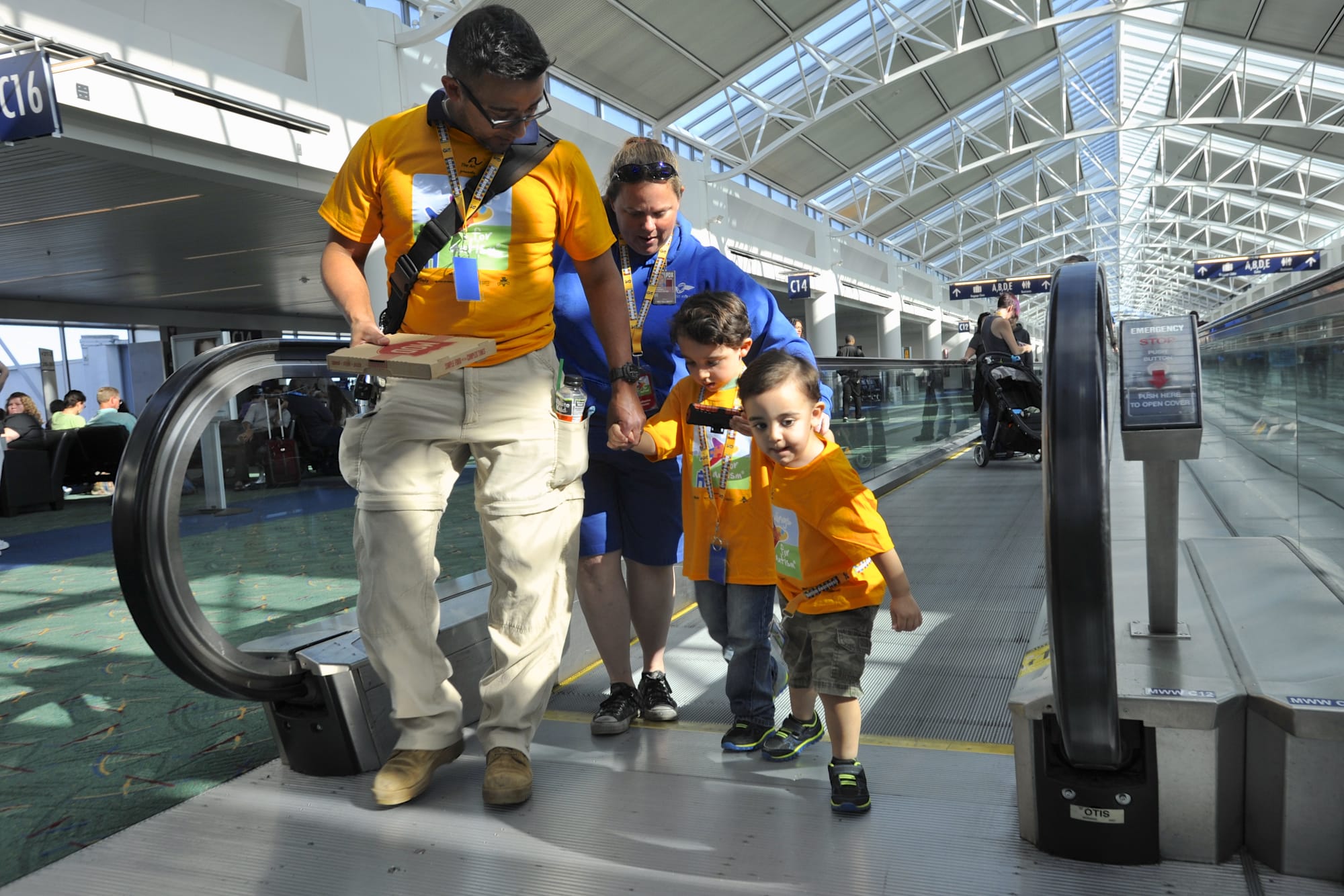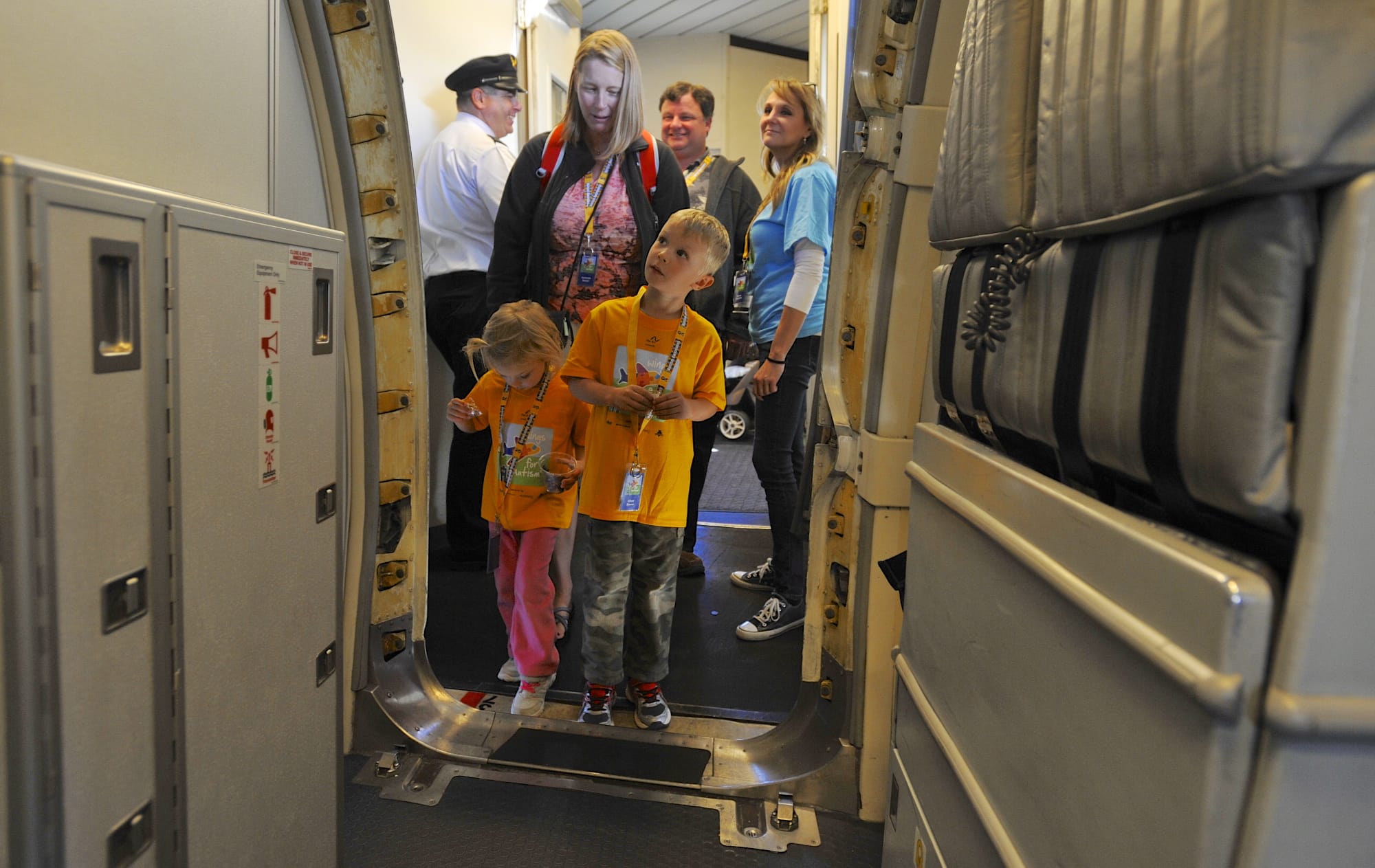PORTLAND — Heading down Airport Way toward Portland International Airport, there’s a big sign boldly proclaiming PDX “America’s Best Airport.” But for someone with autism, the airport with all its sights, sounds, and busyness that can be an overwhelming, overstimulating place. Scary, even.
Mid-afternoon Saturday, the airport is not crowded. And Elliott Beaver is not afraid of the airport.
“Let’s go, guys!” the 6-year-old says while waiting with his family at the Alaska Airlines ticket booth. It’s the waiting game he’s uncomfortable with, says his mom, Jeannette Beaver. Elliott often paces in circles. The Beavers, who live in Vancouver, and other area families with children with autism get to practice going through airport security and boarding a plane, as part of the first Wings for Autism event at PDX hosted by the Arc and the Autism Society of Oregon.
“This is the hardest part,” Jeannette Beaver says, pointing at the queues. Elliott, who’s high-strung and has a high-functioning form of autism, is no stranger to cutting in line and darting in and out of crowds.
“One time he got away from me and almost got on another plane,” Beaver says. That was when Elliott was 2 years old, though.
Time spent waiting in line can be excruciatingly boring for any young child. The TSA line is easy enough for Elliott, especially since they get to go through the express lane for the occasion, but another boy goes through security screaming.
“I want to go to C20 right now,” Elliott says. That’s where they’re boarding the Alaska Airlines plane. “We have to go, and fast.”
With family in Chicago and the Dallas-Fort Worth, Texas area, Beaver hopes to someday be able to travel with her whole family. When they go somewhere, she brings snacks and plenty of tech toys. This time, a playset near the end of the terminal by gate C20 offers enough amusement for Elliott and his 3 1/2 -year-old sister, Abby.
“He didn’t really want to be here, but then he saw all the fun stuff,” says Kassandra Lester, who brought her 4-year-old son Bradley to the airport with her husband Jared. Throughout the morning, the Vancouver couple had reminded their son they were going to the airport to board a plane that wasn’t actually going to take off. At the airport later, Bradley happily bounds around with the other children on the playset. At one point, he picks up a toy in a baby stroller and swiftly sticks it in his mouth.
“What’s nice is everybody here is understanding,” Lester says with a laugh, as her husband gets the toy out of his mouth. Most everyone participating in Wings for Autism wears bright sunflower-yellow T-shirts, making it easy to spot the children running around the terminal. Some are looking out the window at the arriving planes.
Bradley has trouble communicating and will often repeat what other people say, a behavior known as echolalia, or he might randomly burst into song.
It’s not quite time to board the plane printed with a Pacific Northwest salmon known as a Salmon-Thirty-Salmon. Passengers flying in from California have to deboard the plane, first. About 48 percent of flights that come out of PDX are through Alaska Airlines, which takes up much of the C terminal. That means, there’s a good chance families will take this exact route to the C terminal next time they fly for real.
Deanna Hill has been a flight attendant for 23 years and knows that children run the gamut from extreme fear of flying to having a fascination of planes.
“We always have to be the calm ones,” she says, referring to the flight crew.
She suggests families who have trouble flying bring comfort items, such as a movie or music player, headphones and a reusable water bottle. Years ago, a little boy with autism boarded one of her flights and proceeded to say, ‘We’re gonna crash. We’re gonna crash,’ over and over again. Not knowing the boy had autism and some sensory processing issues, Hill touched his arm to help reassure him, which only made him more upset.
“He was just scared,” Hill says. She surmises a program like Wings for Autism, would have been helpful for that family.
While moving through the airport, parents can share information about their children with airline personnel, though they don’t have to, says Ray Prentice, Alaska Airline’s director of customer advocacy. The ticket booth, the TSA line and the boarding gate are natural places to make connections and explain behaviors. And, if there’s time, parents can request their children get a peek at the cockpit to help relieve anxiety, he says.
Lester says her strategy for reducing the likelihood of attention-grabbing behavior is to take a late-night flight.
“That way, he’s at least sleeping most of the night,” she says.
As the families line up to board the plane, Catharine Hunter stays back, away from the crowd with her son, Owen Martinez.
“We’re thinking about going to Hawaii in February,” says Hunter, who works for Southwest Airlines.
When Owen was young — too young to remember, probably — he mostly slept during an airplane ride. He’s a quiet boy, silently playing with a marble maze game near the playset, flapping his arms each time a marble slides to the bottom of the board. Marble mazes just so happen to be his new obsession, Hunter says. He’s also taught himself to read the Russian alphabet and can recite entire Disney movies.
“And yet, he can’t tie his shoes,” Hunter says.
While his younger brother, Joshua, runs around kissing all the children on the playground, Owen stays back. He likes to be around other children but doesn’t like to interact with them, Hunter says. He can get a little agitated in large crowds. In the middle of a Saturday afternoon, concourse C is uncrowded and the noise level a dull roar.
“We tell the parents ‘if they don’t make it this time, that’s OK,’ ” says Karen Wolf-Branigin, senior executive officer at The Arc.
Wings for Autism began as a mother’s idea at The Arc in Boston. Her family of four tried to board a plane at Logan International Airport, only to face a meltdown that resulted in half the family deciding to deboard and return home. The mother wonder whether there was a way to introduce her autistic son to the airport in a safe practice environment.
On Saturday, there were similar Wings for Autism events happening in Seattle, Phoenix and Birmingham, Ala. This year, The Arc aims to hold 20 such events.
Boarded, buckled and seated between his parents, Bradley sits with the brim of his baseball hat down, covering his face.
“He found his happy place,” says Jared Lester. As the plane lingers on the runway, Bradley looks up and begins reciting some fitting lyrics from “Blues Clues.”
“C’mon, let’s go,” Bradley says. “Five, four, three, two, one … blastoff!”
The captain and flight attendants go through all the normal safety proceedings. As the engines roars, and the plane races down the tarmac, Bradley gets quiet and his eyes widen. His dad hold onto him and gently strokes his hand.
The plane doesn’t take off, like it normally would. And, the excursion around the runway ends with applause from most everybody on board — also not normal. For the Lesters, it’s a successful trip that indicates at least short plane treks could be possible.
Just like when he was a toddler, Owen Martinez started to drift off to sleep before the plane took off.
“As soon as the engines revved he went ‘whoa,’ but that was it,” Hunter says. “That went very well.”
That trip to Hawaii might just happen after all.





